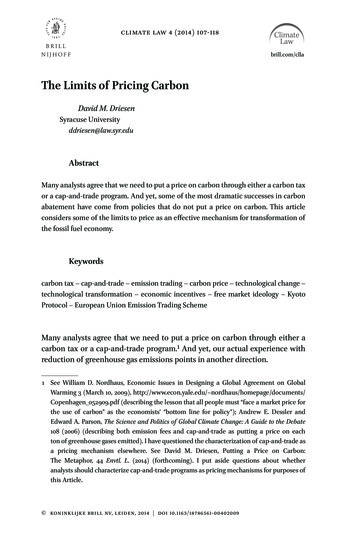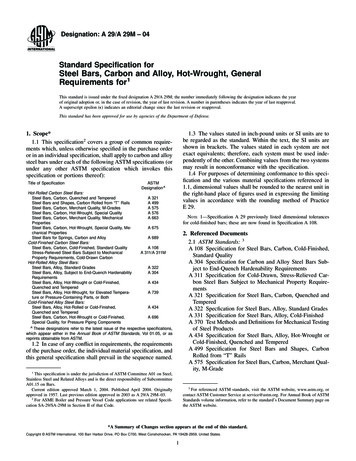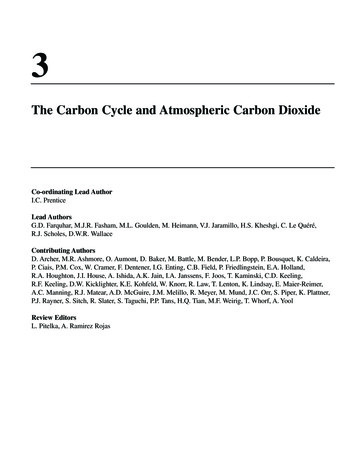
Transcription
The carbon benefits ofcloud computingA study on the Microsoft Cloudin partnership with 2017 Microsoft. All rights reserved.
This white paper is an update to “Cloud Computing and Sustainability: The Environmental Benefitsof Moving to the Cloud,” published in 2010. In this paper, we have expanded the older study toshow how the Microsoft Cloud can accelerate energy savings and reduce carbon emissions.ContentsForeword .3Executive summary .4Introduction: Cloud computing and increasing energy consumption . 5Research approach: Life cycle evaluation of on-premises and cloud IT services . 7Cloud services .7On-premises deployment scenarios. 8Functional units .8Life cycle phases.8Data sources and key parameters . 9Findings: Smaller footprint with the Microsoft Cloud . 10Energy and emissions results by service and deployment scenario . 10Four energy- and carbon-reducing features of the Microsoft Cloud . 11Case study A: A global engineering consulting firm . 14Case study B: A global apparel company . 15Looking ahead: Increasing the environmental benefits of the Microsoft Cloud . 16Appendix I: Key parameters. 17Appendix II: Model assumptions . 19Embedded emissions . 19Transportation. 19Use phase energy . 19End-of-life disposal . 20Model exclusions . 20Appendix III: Energy and carbon benefits of Microsoft Cloud services. 21Azure Compute. 22Azure Storage. 23Exchange Online . 24SharePoint Online . 252The carbon benefits of cloud computing
ForewordToday, a technology revolution is transforming virtually every aspect of life as we know it. Thescale of its impact is on par with the discovery of electricity, such that some are calling this erathe Fourth Industrial Revolution. Powering this revolution are cloud computing and thetechnological advancements that underpin it. With cloud computing, businesses, governments,institutions, and individuals are able to access nearly unlimited computing power at the push ofa button, enabling them to gain insights and make discoveries previously not dreamed of infields such as genomics, robotics, and artificial intelligence. And yet, even as the cloud unlockshumanity’s vast potential, the exponential expansion of IT infrastructure raises questions aboutthe environmental impacts from this growth.At Microsoft, we are committed to sustainable operations in all parts of our business andbeyond, for local and global good. Through our internal sustainability fee, we fund ourcommitments to carbon neutrality and renewable electricity, using the scale of our clouddatacenters to bring more green power onto the grid. We are harnessing the power of the cloudwithin our own business to address our environmental impact: our cloud-based programs toreduce resource consumption have already contributed to our 20 percent global energyreduction at our facilities. Overall, we are on path to a 75 percent reduction in our carbonemissions by 2030 relative to a 2013 base year.We are equally committed to extending the benefits of the cloud beyond our operations to ourcustomers, by working to deliver IT services with a smaller environmental footprint. Increasingdemand for computing services is inevitable, and we aim to support this growth as responsiblyas possible. We engaged external experts to conduct this study, comparing the Microsoft Cloudwith traditional enterprise datacenter deployments. The results show that the Microsoft Clouddelivers impressive sustainability benefits, and point to the opportunity for business and societyto reduce the carbon footprint associated with computing in support of a more sustainablefuture.We invite you to read about the environmental advantages of deploying your applications in theMicrosoft Cloud.Christian BeladyGeneral Manager, Cloud Infrastructure Strategy and OperationMicrosoft CorporationRob BernardChief Environmental StrategistMicrosoft CorporationA study on the Microsoft Cloud3
Executive summaryCloud computing makes it possible to collect, analyze, and store huge quantities of data, reducethe total cost of ownership of IT, and increase business agility. Today, datacenters supportingthe cloud consume a significant, and growing, amount of energy.Societally, moving from many on-premises servers to fewer large datacenters presents theopportunity to reduce overall IT consumption of energy and related carbon emissions. With thisin mind, Microsoft commissioned a study to compare the energy consumption and carbonemissions 1 of four applications in the Microsoft Cloud with their on-premises equivalents:Microsoft Azure ComputeMicrosoft Azure StorageMicrosoft Exchange OnlineMicrosoft SharePoint OnlineWe selected these cloud applications as they together account for about half of the energyconsumed in Microsoft datacenters. To gain as full and accurate a picture as possible, the studyconsidered the full life cycle for the computing scenarios (from manufacturing to end-of-life).The results show that the Microsoft Cloud is between 22 and 93 percent more energy efficientthan traditional enterprise datacenters, depending on the specific comparison being made.When taking into account our renewable energy purchases, the Microsoft Cloud is between 72and 98 percent more carbon efficient. These savings are attributable to four key features of theMicrosoft Cloud (Figure 1): IT operational efficiency, IT equipment efficiency, datacenterinfrastructure efficiency, and renewable electricity.Figure 1*: The four features of the Microsoft Cloud that reduce environmental impact.*kgCO2e kilograms of carbon dioxide equivalentAt Microsoft, our commitment is to create a cloud that is trustworthy, responsible, and inclusive.This study provides a current measurement of the potential energy efficiency and carbonsavings that businesses can realize with the Microsoft Cloud. The impact of using our cloudservices will improve even more as we continue to refine how we manage capacity, boostenergy efficiency, reduce waste, and add new sources of renewable energy.14Throughout this paper, “emissions” and “carbon” refer to all greenhouse gas (GHG) emissions.The carbon benefits of cloud computing
Introduction:Cloud computing and increasing energy consumptionThe world is now entering the Fourth Industrial Revolution, which, as described by the WorldEconomic Forum, will feature major technological advances in artificial intelligence, robotics,genomics, materials sciences, 3D printing, and more. Businesses, governments, and civicinstitutions can now collect, store, and analyze data at an unprecedented scale, speed, anddepth. Big data and deep analytics unlock the potential to make a positive impact throughoutthe world, from conserving the world’s freshwater supply to optimizing energy use in buildings.These improvements add up to financial savings and carbon reductions at a global scale.Cloud computing—large-scale, shared IT infrastructure available over the internet—is theengine enabling these technology advancements. And these advancements, in turn, are drivingcloud uptake. At the same time, the cloud can help businesses reduce their total cost ofownership 2 and realize greater business agility by delivering significant economies of scale andenabling access to data and applications anywhere.But as the world’s use of cloud computing accelerates, so too does the energy consumed in thecloud. In the United States alone, datacenters consume about 70 billion kilowatt-hours (kWh) ofelectricity each year, roughly 1.8 percent of the total electricity consumed in the country. Thisnumber is expected to grow to 73 billion kWh by 2020, about the same amount of energy that 6million homes consume in one year. 3 This number would be higher if not for the efficienciesrealized in many commercial cloud datacenters.Following the Paris Agreement, as climate change gains public attention and as governmentsestablish regulations to curtail carbon emissions, the environmental impact of computing isincreasingly under scrutiny. At Microsoft, we embrace our responsibility to operate sustainablyto reduce the climate impact of our business: we are committed to carbon neutral operationsand purchasing renewable electricity. We are also committed to helping our customersunderstand and reduce the environmental impact of their computing.Total cost of ownership is the total cost of an IT solution or product over time. The metric considersdirect and indirect costs, capital expenses (such as IT equipment), and operating expenses (such asequipment upkeep and software).3Arman Shehabi, Sarah Josephine Smith, Dale A. Sartor, Richard E. Brown, Magnus Herrlin, JonathanG. Koomey, Eric R. Masanet, Nathaniel Horner, Inês Lima Azevedo, and William Lintner. United StatesData Center Energy Usage Report. Berkeley, CA: Lawrence Berkeley National Laboratory. LBNL1005775. 2016.2A study on the Microsoft Cloud5
As part of this commitment, we conducted a study to assess the environmental implications ofcloud computing. Specifically, our objectives were to:1. Assess the energy use and carbon emissions associated with key applications within theMicrosoft Cloud in comparison with their on-premises equivalents.2. Improve our understanding of the energy and carbon benefits of computing using Microsoftand other commercial cloud services in general compared with on-premisesimplementations.The study builds on the 2010 Microsoft report Cloud Computing and Sustainability: TheEnvironmental Benefits of Moving to the Cloud. 4 To conduct this updated study, Microsoftengaged WSP, a global consultancy with expertise in environmental and sustainability issues, tomodel the environmental impact of using Microsoft Cloud services instead of on-premisesdeployments. Stanford University IT sustainability and compute energy expert Dr. JonathanKoomey served as an in-depth technical reviewer.This paper presents the research approach and findings of the study, demonstrating thatMicrosoft Cloud computing offers significant advantages in energy consumption and carbonemissions over on-premises deployments, findings that are consistent with both the originalstudy and other industry research 5.Cloud computing and sustainability: The environmental benefits of moving to the cloud. Accenture,WSP. 2010.5P. Thomond. The enabling technologies of a low-carbon economy: A focus on cloud computing.Microsoft and GeSI. 2013.46The carbon benefits of cloud computing
Research approach:Life cycle evaluation of on-premises and cloud IT servicesThis analysis uses a quantitative model tocalculate and compare the energyconsumption and carbon footprint of ITapplications and compute and storageresources in the Microsoft Cloud withequivalent on-premises deployments (Figure2). The model draws on greenhouse gasaccounting principles from the WorldResources Institute (WRI) and World BusinessCouncil for Sustainable Development(WBCSD) Corporate Standard and Product LifeCycle Standard.Figure 2: Study design: a quantitative evaluation ofMicrosoft Cloud services in comparison with on-premisesdeployment equivalents.Cloud servicesThe study looks at four cloud services that account for nearly half of the energy consumed inMicrosoft datacenters:Azure ComputeAzure StorageExchange OnlineSharePoint OnlineBoth Exchange Online and SharePoint Online were included in the original 2010 study. 6However, in this study, the scope was expanded to include Azure services, which provideinfrastructure as a service (IaaS), above and beyond software as a service (SaaS). Our aim was togenerate a broader and more inclusive spectrum of data points to enable a more accurateassessment of the energy and carbon implications of different types of services used today.Cloud computing and sustainability: The environmental benefits of moving to the cloud. Accenture,WSP. 2010. Note: The original 2010 report focused on three business applications: Exchange Online,SharePoint Online, and Microsoft Dynamics CRM Online.6A study on the Microsoft Cloud7
On-premises deployment scenariosThe study considered a range of on-premises deployment scenarios relative to the fourMicrosoft Cloud services listed previously:Azure Compute comparisons:o Physical serverso Virtualized serversAzure Storage comparisons:o Direct attached storageo Dedicated storageExchange Online and SharePoint Online comparisons:o Small deployments: 1,000 userso Medium deployments: 10,000 userso Large deployments: 100,000 usersFunctional unitsWe analyzed the cloud services and on-premises deployments based on the functional unit foreach cloud service—that is, the “useful output” offered by a deployment. We defined thesefunctional units based on the level of service offered by the Microsoft Cloud. This allowed for anapples-to-apples comparison between the Microsoft Cloud and on-premises alternatives. Thefunctional unit for each service is listed in the following table:ServiceAzure ComputeAzure StorageExchange OnlineSharePoint earQuality and performance criteria 7Net computational outputNumber of data replicationsMailbox size and replicationsProvisioned storage and replicationsLife cycle phasesA life cycle assessment provides a full picture of the environmental impact of a product orservice, from the raw material extraction for equipment manufacturing through the end-of-lifetreatment of equipment. Assessing the full life cycle helps to ensure inclusion of all majoremission sources. In this study, we assessed each of the four cloud services and their onpremises equivalents for energy consumption and carbon emissions impacts across four lifecycle phases, as illustrated in Figure 3 and described following.The quality and performance criteria are proprietary to Microsoft and therefore specific numbersare not shared.78The carbon benefits of cloud computing
Figure 3: The life cycle phases used to define the boundary of energy consumption and carbonemissions considered in the analysis.1. Raw material extraction and assembly—includes the energy consumption and emissionsassociated with the use of the raw materials and the assembly of servers, networkingequipment, and hard drives.2. Transportation—represents the energy consumption and emissions associated withtransporting the servers and other IT equipment from the manufacturer to Microsoftdatacenters or on-premises datacenters.3. Use—encompasses the energy consumption and emissions from electricity used to run theservers, networking equipment, hard drives, and datacenter infrastructure, such as lighting,cooling, and power conditioning. Where relevant, includes energy from data flows over theinternet.4. End-of-life disposal—includes end-of-life energy consumption and carbon emissionsassociated with landfilling and recycling, based on conservative assumptions about recyclingrates.Data sources and key parametersPrimary data from Microsoft datacenters and equipment were used wherever possible, andsecondary data such as industry averages were used as necessary.Key parameters considered in the analysis included:Equipment counts and specifications.Device utilization.Power draw of servers, storage devices, and networking equipment used within thedatacenters.Power usage effectiveness (PUE) of datacenters hosting the services.Data flows over the internet.Carbon intensity of electricity supply.Equipment counts, equipment specifications, and power draw for Exchange on-premisesdeployments were determined using the Exchange Server Role Requirements Calculator forExchange 2016. On-premises Exchange, SharePoint, compute, and storage equipment countsand specifications were supplied by industry experts whose primary role is to deploy thesesolutions for enterprises. The Microsoft Cloud analysis was based on actual data collected fromcurrent Microsoft datacenter operations.For a detailed description of each of these key parameters and model assumptions, please seeAppendix I and Appendix II.A study on the Microsoft Cloud9
Findings:Smaller footprint with the Microsoft CloudThe results of this study reveal significant energy efficiency improvements—from 22 to93 percent—when switching from traditional enterprise datacenters to the Microsoft Cloud forany of the four services. The specific savings achieved vary by service and deployment scenario.The greatest relative savings are realized when smaller enterprise deployments transition to thecloud. The features driving these reductions for the Microsoft Cloud include more efficientoperational practices, IT equipment, and datacenter infrastructure. These efficiencies translateinto both energy and carbon savings. When also accounting for our purchases of zero-carbonelectricity, emissions savings with the Microsoft Cloud can be as great as 98 percent.Energy and emissions results by service and deploymentscenarioMicrosoft Cloud services achieve energy and emissions reductions in comparison with every onpremises deployment scenario assessed. The primary driver for energy and emissions reductionsin each comparison is decreased electricity consumption per useful output during the use phasein the datacenters that run the Microsoft Cloud. Figure 4, following, shows the range of savingsby service based on deployment scenario as described in the On-premises deploymentscenarios section earlier.Figure 4: The range of energy and emissions savings by cloud service. “Energy savings” shows theenergy savings of the datacenter electricity used in Microsoft Cloud services over the on-premisesequivalents. “Emissions savings (with renewables)” shows the emissions savings of the MicrosoftCloud services over the on-premises equivalents, taking into account the purchase of zeroemission renewable electricity to power the Microsoft Cloud.For detailed data sheets by service, see Appendix III.10The carbon benefits of cloud computing
Four energy- and carbon-reducing features of the MicrosoftCloudFour main drivers contribute to the smaller energy and carbon footprint of the Microsoft Cloud(as illustrated in Figure 5). The first three—IT operational efficiency, IT equipment efficiency, anddatacenter infrastructure efficiency—reduce the energy required to deliver the services. Thefourth is the purchase of renewable electricity for more than 95 percent of our consumption,which translates into a smaller carbon footprint for electricity consumed in Microsoftdatacenters. The remaining carbon emissions associated with the Microsoft Cloud are primarilyfrom aspects of the life cycle outside Microsoft datacenters (that is, embedded carbon in the rawmaterials, equipment assembly, transportation, data flows, and end-of-life disposal).Figure 5*: The four features of the Microsoft Cloud that reduce environmental impact.*kgCO2e kilograms of carbon dioxide equivalentThe first three drivers of the reduced footprint (IT operational efficiency, IT equipment efficiency,and datacenter infrastructure efficiency) typically apply across all commercial cloud serviceproviders, and even some on-premises scenarios, but will vary depending on factors such as thephysical infrastructure and operational standards. Only cloud providers and private datacentersthat purchase or use large volumes of renewable electricity will be able to achieve a carbonfootprint comparable with the Microsoft Cloud.1. IT operational efficiencyThe large economies of scale seen in cloud computing mean that commercial cloud services ingeneral can operate with much greater IT operational efficiency than smaller, on-premisesdeployments.Dynamic provisioning—Emphasis on application availability can lead to overprovisioningof computing resources to avoid theoretical unmet demand. Improved matching of servercapacity with actual demand minimizes waste. Microsoft manages capacity efficiently toavoid expensive overprovisioning, through monitoring and demand prediction that allow forcontinual capacity adjustment.A study on the Microsoft Cloud11
Multitenancy—Microsoft uses multitenancy, occupying servers with multiple user types anda large user base with different demand patterns. Just as the electric grid interconnectsthousands of users whose fluctuating power demands can balance one another, cloudinfrastructure hosts thousands of companies and millions of users whose different usepatterns can balance one another. This load diversity decreases overall fluctuations andmakes loads more predictable. Generally, as the number of users increases, the ratio of thepeak demand to the average demand for the user set decreases. Therefore, rather thansizing equipment to meet a single customer’s peak load (for example, workers arriving at anoffice in the morning and immediately checking email), Microsoft sizes equipment to meetthe time-coincident demand of the whole user set.Server utilization—Higher equipment utilization rates mean the same amount of work canbe done with fewer servers, which in turn leads to less electricity consumed per usefuloutput. While servers running at higher utilization rates consume more electricity, the overallperformance gains more than offset the relative per-unit increase. As illustrated in Figure 6,increasing the utilization rate from 10 percent to 40 percent will allow a server to processfour times the previous load, while the power draw by the server may only increase 1.7times. 8 Moreover, newer processors are continually driving towards a more attractive loadcurve where power draw is significantly reduced at idle or low utilization rates. The typicallyfaster equipment replacement rates for commercial cloud service providers position them totake advantage of these improvements sooner than in on-premises deployments.Figure 6: As utilization increases, power per computational output decreases.Based on representative sampling of volume servers manufactured in the last two years, asmeasured using SPECpower ssj2008 protocol from the Standard Performance Evaluation Corporation(SPEC).812The carbon benefits of cloud computing
2. IT equipment efficiencyBecause Microsoft spends a significant portion of operating expenses on electricity to run ITequipment, more so than the typical corporate IT department, we have a strong financialincentive to optimize IT efficiency. We take an active role in tailoring hardware components tothe specific needs of the services we run, meaning the equipment runs leaner with a higher ratioof input energy going towards providing useful output than in traditional enterprisedeployments. By collaborating with suppliers on the specification and design of servers andother equipment for maximum efficiency, Microsoft can realize benefits from scale that mostcorporate IT departments are unable to address. The results of this study suggest that morespecialized, efficient IT equipment can reduce electricity consumption by 10 percent or more.3. Datacenter infrastructure efficiencyAdvanced infrastructure technologies in hyperscale datacenters reduce electricity requirementsfor overhead tasks such as lighting, cooling, and power conditioning. Power usage effectiveness(PUE)—the ratio of overall electricity consumption at the datacenter facility to the electricitydelivered to the IT hardware—is a common measurement of how efficiently a datacenter useselectricity. The hyperscale datacenters that power the cloud are able to achieve better PUEs thantypical enterprise datacenters. At Microsoft, we are committed to measuring PUE at eachdatacenter, and we are implementing better monitoring techniques and innovative design tocontinuously improve our PUE.4. Renewable electricityConsolidating distributed electricity demand from on-premises datacenters into the cloudunlocks the potential for large-scale purchases of green power that bring substantial renewableenergy projects onto the grid that were not otherwise viable. We are committed to relying on alarger percentage of wind, solar, and hydropower electricity over time at our datacenters. Ourgoal is to achieve 60 percent direct purchase of wind, solar, and hydropower early in the nextdecade and then to keep improving from there. When we’re not able to eliminate energy use ordirectly power our operations with green energy, we obtain zero carbon electricity through thepurchase of renewable energy certificates. Counting these certificates, we purchase renewableelectricity for more than 95 percent of our consumption, including electricity associated withservices hosted in the Microsoft Cloud. For further discussion of how this is included in thecalculations, see Appendix III.A study on the Microsoft Cloud13
Case study A:A global engineering consulting firmTo assess the sustainability of the Microsoft Cloud in a real-world setting, this case studycompared the energy and carbon footprint of a global engineering consulting firm that hostsroughly 10,000 users in Europe on Exchange 2016 on-premises with the equivalent footprint inthe Microsoft Cloud.The firm’s implementation ofExchange was not as robust asthe services offered by ExchangeOnline because the firm’sdeployment only had threecopies of each database spreadover two datacenters and a 5gigabyte (GB) size limit for eachmailbox. In contrast, even theFigure 7: Contrasting the on-premises deployment of Exchange for amost basic Exchange Online plansample global engineering consulting firm (10,000 users) with theoffers 50 GB of mailbox storagecorresponding deployment in the Microsoft Cloud, which offershigher redundancy and availability.and, for most customers, fourdatabase copies spread acrossfour geographically distinct datacenters to allow high levels of data redundancy and availability(as shown in Figure 7).Even while supporting a more robust Exchange environment than the on-premises deployment(with the additional infrastructure and energy demands that this entails), the Microsoft Cloud isestimated to reduce emissions by 93 percent compared with the on-premises environment(Figure 8). These emissions reductions are a result of 6,000 kWh in energy savings and Microsoftrenewable electricity purchases.Figure 8*: Life cycle emissions results for an Exchange deployment for asample global engineering consulting firm (10,000 users), showingemissions savings with the Microsoft Cloud versus on-premises.*kgCO2e kilograms of carbon dioxide equivalent.14The carbon benefits of cloud computing
Case study B:A global apparel companyTo assess the sustainability of the Microsoft Cloud in a real-world setting, this case studycompared the energy and carbon footprint of a global apparel company’s use of Azure vi
Exchange Online and SharePoint Online comparisons: o Small deployments: 1,000 users o Medium deployments : 10,000 users o Large deployments: 100,000 users Functional units We analyzed the cloud services and on-premises deployments based on the functional unit fo r each cloud service—that is, the "useful output" offered by a deployment. We .











